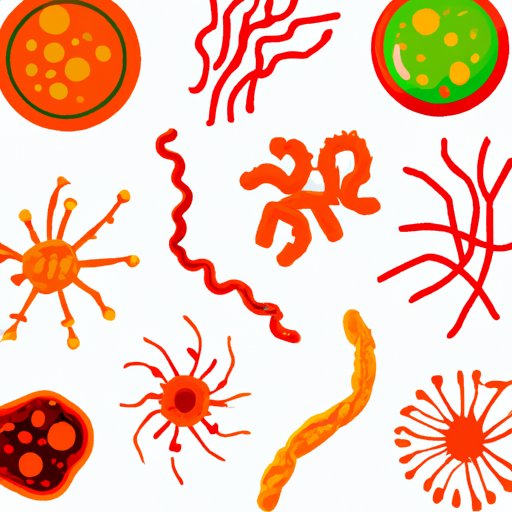Introduction
Microbes are tiny organisms that play a vital role in our lives. Although invisible to the naked eye, they are present in every aspect of our environment, from the air we breathe to the food we eat. In this article, we will explore the basics of microbes, their impact on the world, and the importance of understanding them.
Exploring the Unseen World: Understanding the Basics of Microbes
Microbes, also known as microorganisms, are living creatures that are too small to be seen without a microscope. They include bacteria, viruses, fungi, protozoa, and algae. They are everywhere around us, in the soil, water, air, and our bodies.
Microbes are incredibly tiny, with some being only a few micrometers in size. To put that into perspective, a micrometer is one-thousandth of a millimeter. That means you could fit several thousand microbes on the period at the end of this sentence.
Microbes can be found in almost every environment on Earth, from the deepest sea to the highest mountain peaks. Some microbes live in extreme environments, such as hot springs or ice-cold polar regions, where few other organisms can survive.
Studying microbes is essential to understand their impact on the world. Microbes play a vital role in many processes such as nutrient cycling, decomposition, and water purification. Without microbes, life on Earth would be impossible.
The Good, the Bad, and the Tiny: Why Microbes Matter
Microbes can have both positive and negative impacts on life. These tiny organisms are essential to the existence of life as we know it, but they can also cause disease and decay.
Microbes play a crucial role in different ecosystems. They decompose dead organic materials, which releases nutrients into the soil. In turn, allows plants to grow, providing food for animals and other organisms. Microbes also contribute to the production of food and beverages such as cheese, yogurt, and beer.
However, some microbes can be harmful to human and animal health. The diseases caused by microbes are widespread, from the common cold to more severe illnesses like tuberculosis, cholera, and COVID-19.
From Bacteria to Viruses: A Comprehensive Guide to Microbes
Microbes come in different shapes, sizes, and forms, each with unique characteristics and behaviors. The most common types of microbes are bacteria, viruses, fungi, protozoa, and algae.
Bacteria are single-celled organisms that can be found almost anywhere on Earth. Some types of bacteria are essential to life, such as those in our gut that help with digestion. Others can cause infections and diseases such as strep throat and pneumonia.
Viruses are small infectious agents that cannot survive outside a host cell. They come in many shapes and sizes and can infect animals, plants, and even bacteria. Some viruses can cause mild illnesses like the common cold, while others, such as Ebola and HIV, can be deadly.
Fungi are diverse organisms that include yeasts, molds, and mushrooms. They help break down dead organic matter, and some are used in the production of food and medicine. However, some fungal infections can cause serious health problems, especially in people with weakened immune systems.
Protozoa are single-celled organisms that can be free-living or parasitic. They play a crucial role in the food chain, and some are harmful to human health, causing diseases such as malaria and sleeping sickness.
Algae are photosynthetic microbes, ranging from single cells to large seaweeds. They are important for producing oxygen on Earth and also play a role in the food chain as a food source for many aquatic organisms.
The Surprising Diversity of Microbes and Their Impact on Our Planet
Microbes are incredibly diverse, with millions of species living on Earth. They play a vital role in the environment, from breaking down organic matter to nitrogen fixation.
Microbes also play a crucial role in the conservation of biodiversity. They are responsible for maintaining the health of ecosystems and the survival of many species, including plants and animals. By studying microbes, we can learn how to manage and protect the environment better.
Microbes and Disease: How These Tiny Organisms Can Wreak Havoc on Our Health
Microbes can cause a wide range of infectious diseases that can be mild or life-threatening, depending on the type of microbe and the health of the individual infected. Some common infectious diseases caused by microbes include the flu, tuberculosis, and strep throat.
Microbes cause disease by damaging cells and tissues in the body, producing toxins, or evading the immune system. To prevent the spread of infectious diseases, it is essential to practice good hygiene, such as washing hands regularly and avoiding close contact with sick people.
Unleashing the Power of Microbes: How They Are Revolutionizing Science and Technology
Microbes have immense potential to revolutionize science and technology, from medicine to biotechnology and beyond. They can be used to produce medicines, fuels, and biochemicals, among other things.
Research on the use of microbes in biotechnology has already led to the development of many useful products for humans. For example, bacteria are used to produce insulin for people with diabetes, and microbes are used to break down pollution in the environment.
However, as we explore the uses of microbes, we must ensure that we do so responsibly and ethically. There are potential risks associated with the use of microbes, such as the spread of disease and environmental damage.
Conclusion
In conclusion, microbes are tiny organisms that play a crucial role in the environment, human health, and technology. By studying microbes, we can unlock their potential to benefit society while minimizing the risks associated with their use. Indeed, understanding microbes is vital to keeping ourselves and the planet healthy.
